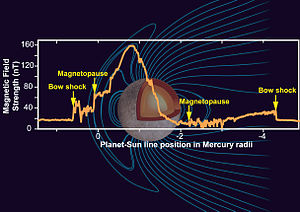Mercury's magnetic field

Graph showing relative strength of Mercury's magnetic field.
|
|
| Discovery | |
|---|---|
| Discovered by | Mariner 10 |
| Discovery date | April 1974 |
| Internal field | |
| Radius of Mercury | 2,439.7 ± 1.0 km |
| Magnetic moment | 2 to 6 × 1012T•m3 |
| Equatorial field strength | 300 nT |
| Dipole tilt | 0.0° |
| Solar wind parameters | |
| Speed | 400 km/s |
| Magnetospheric parameters | |
| Type | Intrinsic |
| Magnetopause distance | 1.4 RM |
| Magnetotail length | 10–100 RM |
| Main ions | Na+, O+, K+, Mg+, Ca+, S+, H2S+ |
| Plasma sources | Solar wind |
| Maximum particle energy | up to 50 keV |
| Aurora | |
Mercury's magnetic field is approximately a magnetic dipole (meaning the field has only two magnetic poles) apparently global, on planet Mercury. Data from Mariner 10 led to its discovery in 1974; the spacecraft measured the field's strength as 1.1% that of Earth's magnetic field. The origin of the magnetic field can be explained by dynamo theory,. The magnetic field is strong enough near the bow shock to slow the solar wind, which induces a magnetosphere.
The magnetic field is about 1.1% as strong as Earth's. At the Hermean equator, the relative strength of the magnetic field is around 300 nT, which is weaker than that of Jupiter's moon Ganymede. Mercury's magnetic field is weaker than Earth's because its core had cooled and solidified more quickly than Earth's. Although Mercury's magnetic field is much weaker than Earth's magnetic field, it is still strong enough to deflect the solar wind, inducing a magnetosphere. Because Mercury's magnetic field is weak while the interplanetary magnetic field it interacts with in its orbit is relatively strong, the solar wind dynamic pressure at Mercury′s orbit is also three times larger than at Earth.
Whether the magnetic field changed to any significant degree between the Mariner 10 mission and the MESSENGER mission remains an open question. A 1988 J.E.P. Connerney and N.F. Ness review of the Mariner magnetic data noted eight different papers in which were offered no less than fifteen different mathematical models of the magnetic field derived from spherical harmonic analysis of the two close Mariner 10 flybys, with reported centered magnetic dipole moments ranging from 136 to 350 nT-RM3 (RM is a Mercury radius of 2436 km). In addition they pointed out that "estimates of the dipole obtained from bow shock and/or magnetopause positions (only) range from approximately 200 nT-RM3 (Russell 1977) to approximately 400 nT-RM3 (Slavin and Holzer 1979b)." They concluded that "the lack of agreement among models is due to fundamental limitations imposed by the spatial distribution of available observations." Anderson et al. 2011, using high-quality MESSENGER data from many orbits around Mercury – as opposed to just a few high-speed flybys – found that the dipole moment is 195 ± 10 nT-RM3.
...
Wikipedia
